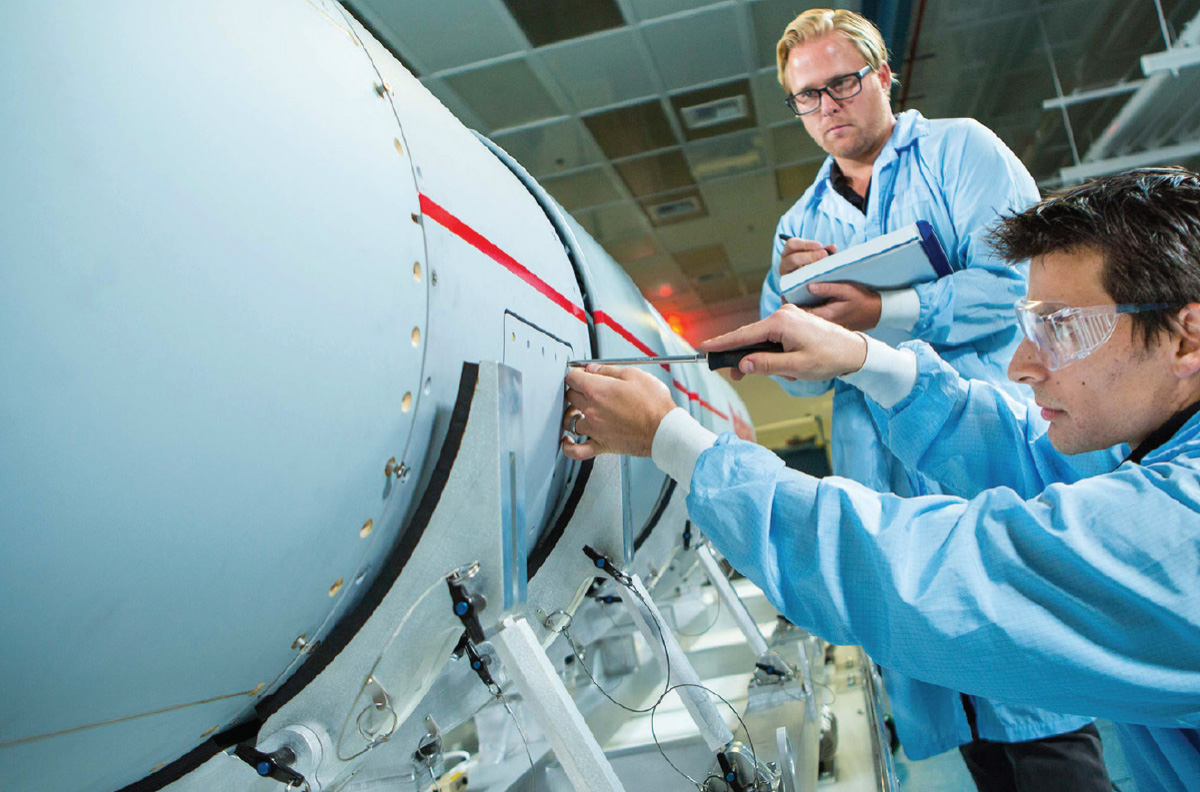
Raytheon’s Space Factory
A National Asset to Protect the U.S. and its Allies
By Dave Perry
At its Space Systems Operations facility – the Space Factory – in Tucson, Raytheon produces interceptor technologies that eliminate attacking short- and medium-range ballistic missiles in space.
How hard is it to strike a missile?
“The analogy we use is it’s like hitting a bullet with a bullet,” said Randy Kempton, VP of strategic engagement systems. “They’re going so fast in space.” Raytheon’s Standard Missile-3 hits its target with “the force of a 10-ton truck traveling about 600 mph.”
Life-protecting precision is essential for the SM-3, a critical component of the U.S.’ missile defense capabilities. Its exactitude comes in part from an optical sensor, “the key in hitting these incoming ballistic missiles,” Kempton said. The ability to identify the specific target, and to “pick it out” in space, is “the secret sauce, so to speak.”
Optics, sensors and interceptors are created in the 49,000-square-foot Space Factory, one of the cleanest buildings in the world with a team of 270 people.
The very sensitive optics of the interceptor must be built in a sterile chamber in the cleanest possible environment so that, when the kill vehicle enters the blackness of space, it can distinguish its target from all distractions,” said Dana Michaud, director of Raytheon’s Space Systems Operations.
“Any little particle on our sensor can be picked up and confused for the target,” Kempton said. “We don’t want any particles at all on the sensors. It has to be super, super clean, given the space environment.”
The Space Factory houses dozens of clean rooms equipped with space-simulating technologies to support production and testing of complex space hardware. Factory cleaning crews work around the clock, thoroughly scrubbing all surfaces and floors. Air within a room can be completely exchanged every 27 seconds. It can be cleaned to 10 microns or less of particulate per cubic foot per air. To compare, a human hair is 70 microns wide.
“That’s significantly cleaner than most operating rooms or various levels of semiconductor plants,” Michaud said. Operators are fully covered head-to-toe “like an astronaut” during phases of the factory’s space simulating processes.
“It’s a world-class space factory,” Kempton said, “a crown jewel in terms of building our sensors for our defensive weapons. I’m highly biased. What we do in the Space Factory is unbelievable. Ours is the best in the world.”
The Department of Defense agrees. In visits to the Space Factory, DOD personnel have identified it as a national asset to protect the U.S. and its allies.
Along with cleanliness, Michaud attributes Raytheon’s intercepting capability to patented technologies and manufacturing processes, and to the “deep well of expertise and experience among its technicians and engineers.”
“We have all the talent to build sensors in Tucson,” Kempton said. And those people have the workspace and the technology to excel.
Since expanding The Space Factory in 2015, Raytheon has invested more than $40 million to modernize its manufacturing capability. It has increased use of robotics, added super-cold cryogenic chambers for space-simulated testing, and enhanced its clean micro-environment capabilities. Further, Raytheon has added a first-of-its-kind, 3-axis shock and vibration system, which creates space flight frequencies for testing without disrupting the product’s configuration.
“We are absolutely always looking to invest and figure out what we need to do to keep up with technology,” Kempton said. “Always.”
Raytheon invests in people, too. Kempton points to Raytheon’s “great partnership” with the University of Arizona. It “starts at the top,” he said.
Raytheon President Wes Kremer and UArizona President Dr. Robert C. Robbins speak regularly. Raytheon works directly with UArizona engineering, exchanging information, offering mentorships and “tons of internships,” participating in a curriculum advisory board, and funding internal research and development projects.
“Typically, we hire about 150 UofA graduates a year,” Kempton said. “The internships provide a huge pool of people we bring in full time.”
He recently returned from a “huge test,” during which Raytheon’s interceptors simultaneously struck two simulated ballistic missile targets. Standard Missile-3 has more than 35 successful exoatmospheric intercepts, he noted, “which is highly, highly impressive.”
The advances, and the testing, must continue, for many reasons. “Our adversaries are always making adjustments to their side of the equation,” Kempton said, “and we’re always adjusting our side.”
“Unfortunately, when you look at world events, and the threats, there is a long future for The Space Factory, for sure,” he said. “Nobody wants conflict in the world. We want to deter. It’s all about having capabilities to deter conflict.”





